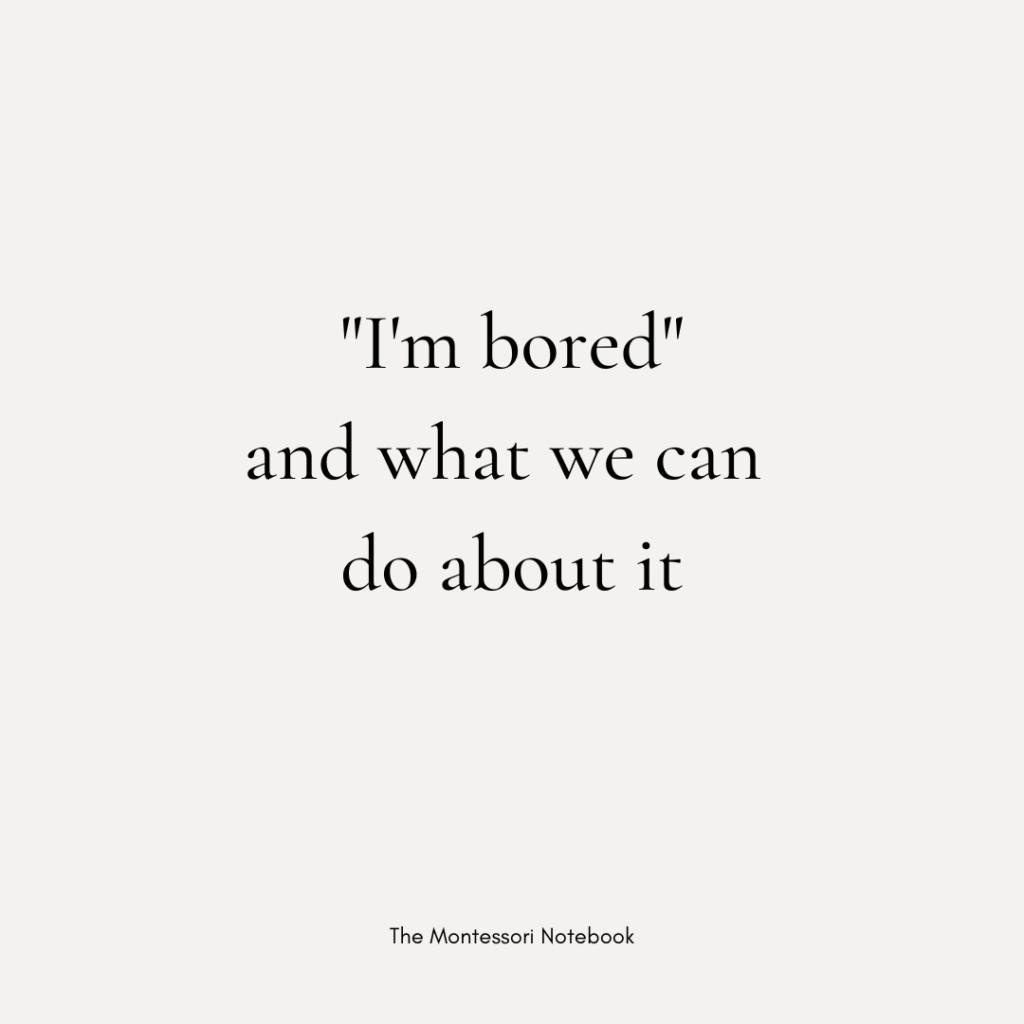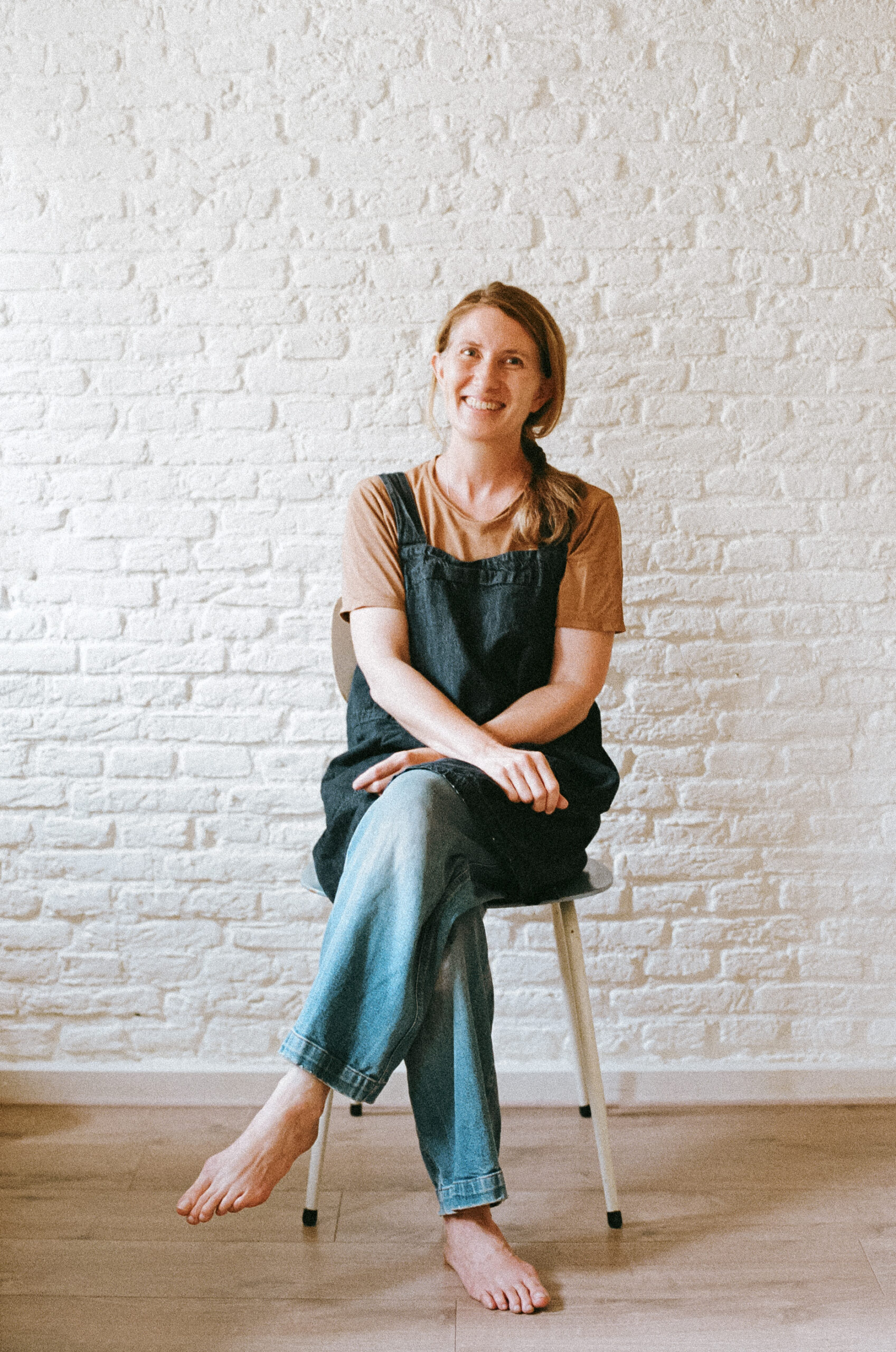“I’m bored!” and what we can do about it

Do you feel bad when your child says, “I’m bored!”? Sometimes we feel like we have to constantly be available to entertain our child/ren. We have children because we want to enjoy their company, share experiences, watch them grow, and support them when needed. And we can also create inspiring environments that our children can use to develop themselves, with us there alongside them as their guide, not their entertainer.
THE ENVIRONMENT
We can use our home environment to help:
1. By setting up activities around our child’s interests
For a baby, are they focusing on visual development, aural development, movement of their limbs, language, grasping skills etc?
For a toddler, are they interested in self-expression like drawing and painting, language, posting, threading, puzzles, sequencing, making music, dancing, climbing, walking, carrying heavy objects, cleaning, washing hands, preparing food, sweeping, raking, watering plants etc?
For a preschooler are they working on longer sequences (like flower arranging), having longer conversations, interested in books and poetry, more complicated food preparation, moving their body in coordinated ways, playing an instrument, playing pretend about their daily life, gardening, showing interest in colours, numbers or letters etc?
For a 6-12 child are they interested in creating big work, working in an atelier, building, making art, music, dance, playing sport, reading, researching, helping others, going out to get more information about their deep interests like architecture or bees or healing the earth etc.
For more ideas, there is a list of activities for babies, toddlers and young preschoolers HERE and my favourite activities by age HERE.
2. By displaying them in an attractive way
Having everything in a toy box or stacked in a cupboard might keep everything out of the way but is not so easy for our children to find what they need. Or our house might be covered from end to end with possibilities that our children end up finding it difficult to decide what to choose or use everything and then feel overwhelmed to tidy it away at the end of the day.
Instead as the adult we can be like a curator. We can store most of their things and keep out only those things that they are most interested in right now or working to master.
For young babies, this could be on a low open shelf that they can scoot over to reach a few accessible items. For toddlers, we can place the items on a tray to help hold everything they need at the ready and enable them to carry it when they wish to use it. For preschoolers and older children, they may be able to start collecting the things they need from a supply shelf and returning them when they are done.
We do this so that the child is attracted to the environment, so they want to interact with it, explore, be creative, have fun and develop themselves at the same time.
3. By having a place for everything and everything in its place
When we have a special place for everything, it provides external order. Babies and toddlers have a strong sense of order and we can show them once where their shoes belong and they will know this is their special place. Preschoolers also thrive knowing how they can access their activities, their clothing, and how to set the table for a meal.
Order is also important for the 6-12 child who are themselves no longer so interested in external order (as they focus on internal order, how things work, why different people do things differently etc) but practically find it helpful by things being where they can expect them (e.g., being able to find their musical instrument or sports equipment for practice), where they have always gone (e.g., laundry in the hamper in the bathroom), and how they can maintain their space (e.g., having a place for their record collection or other collections).
4. By setting things up so our child can help themselves
I remember having a cup of tea at one of Oliver’s friend’s place as the children played together. Every few minutes they would come in to ask for a pen, some tape, some scissors, a stapler – they had some big ideas that they were wanting to put into action. Each time the other child’s parent would get up, rummage through some drawers, find the requested item and we’d return to chatting while they played some more. Until the next request inevitably arose.
In situations like this, we can set up our home so they can find the things they often need within easy reach. This could be creating a supply area in an area where they do art and craft. Or it could be having a box of tissues at their level for a runny nose (or a few folded tissues if a young toddler is too tempted to pull them all out).
Safety: For babies and toddlers we’ll limit this to what they can also safely manage and bring out things like scissors when we are available to supervise them.
THE ADULT
Our role as the adult then is:
- To set up this prepared environment – some time up front means the child has an engaging space to explore
- To observe and adjust the environment – an ongoing process
- To be available to supervise – this is neither a laissez-faire nor an autocratic approach
- To sow seeds of interest – Dr Montessori wrote in To Educate the Human Potential, “The secret of good teaching is to regard the child’s intelligence as a fertile field in which seeds may be sown, to grow under the heat of flaming imagination.” As parents and caregivers, we can also take this role to ignite their interests.
- To step in to assist them when needed – as little as possible, and as much as necessary
- To allow large blocks of uninterrupted time – for them to explore and make discoveries
We definitely don’t ignore our children or expect them to always play alone and we also don’t take over or feel like we need to initiate or lead their play.
Instead we might:
- ask a question like, “I wonder why…?”and see if this gets them interested in exploring something new
- sketch some boxes on a blank piece of paper and start drawing a very amateur comic strip based on something they have shown interest in and see if they get interested to take over or draw their own
- ask if they’d like to help us in the kitchen and allow them to take over more and more steps
- make some playdough together and then let them explore the playdough by themselves
- set up some invitations to play based on their interests – if we don’t know we could place out a few things and see which things they are most attracted to
Then we leave them to explore these possibilities. We let them construct themselves through their play. A baby discovers how they make the bell ring; a toddler learns to put on their jacket with a coat flip; a preschooler is delighted to learn about geography, botany, the world around them; and 6-12 child wants to explore the universe with their imagination.
They can say “I’m bored!” and we can remain solid knowing we are there not to entertain them, but be their companion on this journey as their guide. They will also see us doing things for ourselves that are important to us. They will see us sometimes resting, making ourselves a cup of tea, or reading a book.
There are still so many moments for connection when we explore nature together, go on long walks, have conversations, hug them when they graze their knee, play board games, listen to music on Sunday evenings, have special weekend breakfasts by candlelight and make memories from family and cultural rituals, celebrations and watching them become the most beautiful version of themselves.
THE CHILD
Much as they might complain that they are bored, they need lots of unscheduled time to decompress, time to let their imagination run wild, and time to be creative.
When we limit the environment (or head outdoors), they often come up with the most inventive ideas. I recently came across photos of Oliver and Emma around 6 and 7 years old visiting their grandmother’s house. They were playing with a helium balloon and trying to find a way to attach it to a small teddy bear to make it float down the staircase. We spent hours at the playground down the road where there was a water pump and some sand. They made moats and pathways and were determined to make a dam to keep the water in. Even before they could read they would sit with books and turn the pages (in any random order) in addition to the many hours of reading together and them then reading to me.
We don’t need to lecture them and tell them it’s good for them to get bored. We can notice when they came up with a way to entertain themselves: “I saw you built a fortress from those blocks, that marble run and the kinetic sand. Ha. Who would have thought?”
We can acknowledge when they are feeling bored, without rushing to a solution: “You really feel like there’s nothing to do. Sometimes doing nothing feels hard! I can’t wait to see what you come up with.” (said without sarcasm)
And we are there to link them to the environment, to keep sowing the seeds of interest, and let them take it from there. With us alongside them.

Simone Davies has more than 20 years’ experience as an AMI Montessori educator. Simone is the author of “The Montessori Toddler” and co-author of “The Montessori Baby” and “The Montessori Child” books, comprehensive guides to raising children in a Montessori way. She currently runs parent-child Montessori classes in Amsterdam at her school Jacaranda Tree Montessori. She also has a popular blog, instagram and podcast “The Montessori Notebook” and is mother to two young adults.